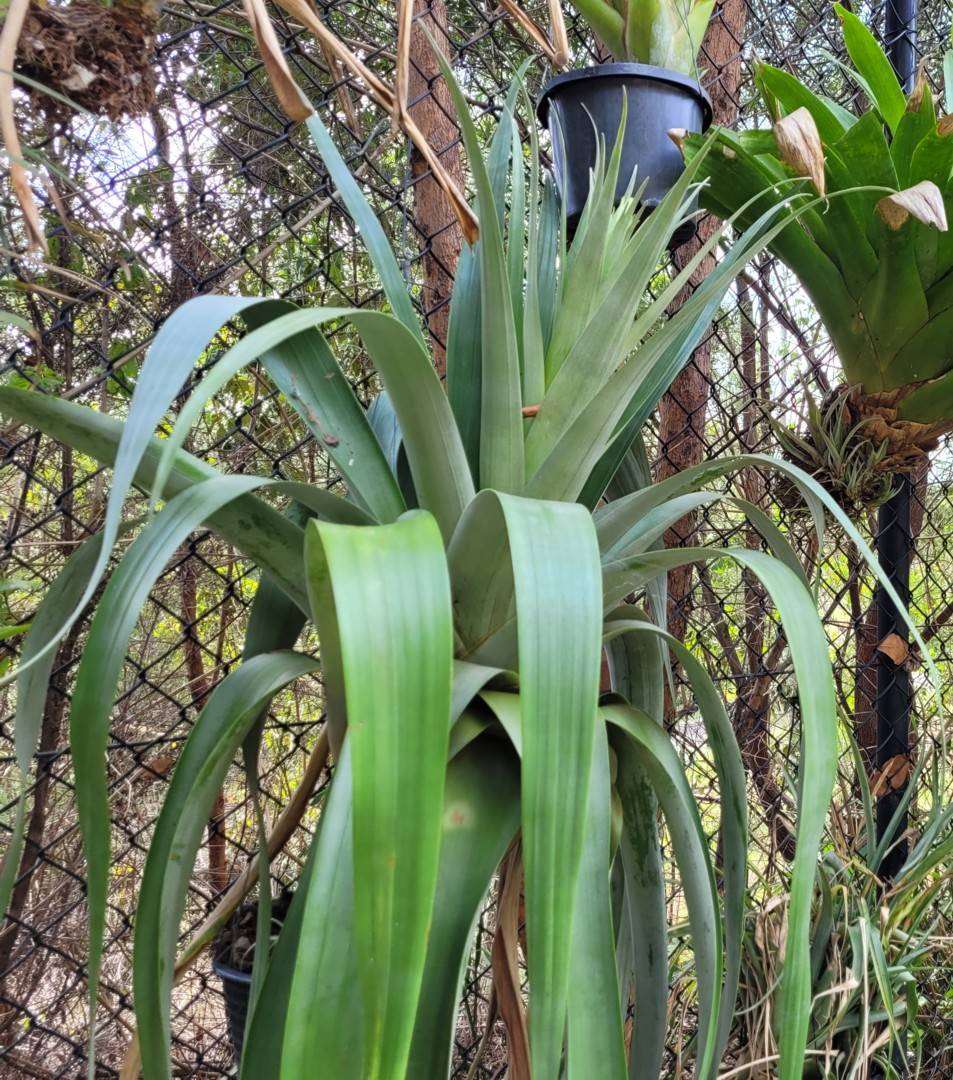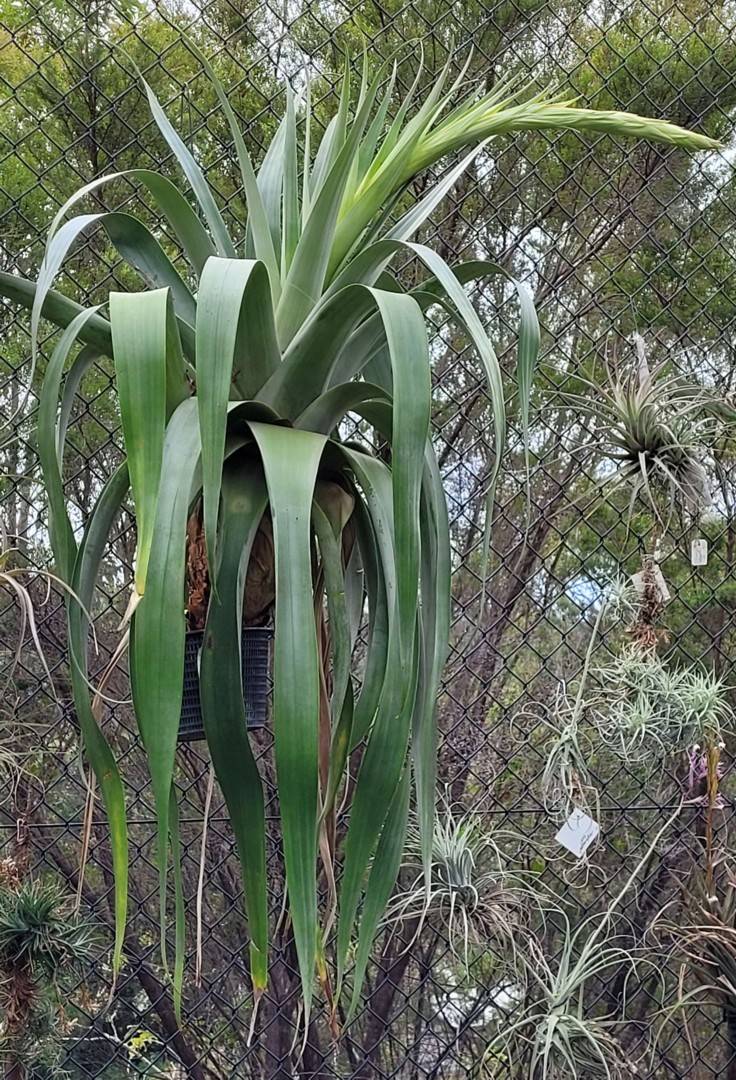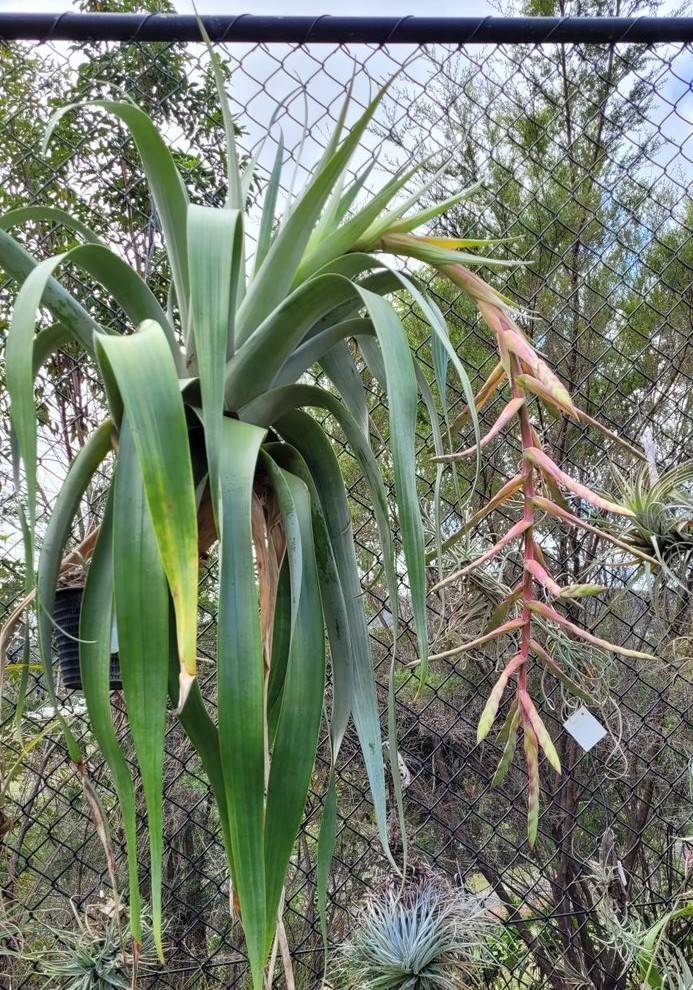


On discovery in Mexico. Travelling from Tehuantepec to El Cameron (Part 2,).
In the last few years, the author went to Mexico repeatedly with the same team of bromeliad enthusiasts, and in this travel report he describes some places along the Mex 190 in Southern Oaxaca. By travelling in the same areas several times, the author became aware of the destruction of forest habitats, in particular. The area close to the two towns of Tehuantepec and Juchitan is characterised by a dry and hot climate; plants are merely represented by xeromorphic shrubs, candelabrous cacti, e.g., Cephalocereus, and saxicolous Hechtia. In search for the spring of Rio Tehuantepec, the team crossed several climatic zones with, e.g., Mammillaria woburnensis, Epiphyllum sp., Selenicereus grandiflorus ssp. lautneri, Hechtia sp., Tillandsia ionantha, T. aff. makoyana. T. cf. flavobracteata, orchids, and Peperomia spp. in dry areas below 1000 m; T. juncea, T. punctulata, T. tricolor, T. viridiflora, T. fasciculata, T. seleriana, and Catopsis cf. subulata on pine trees growing under moist conditions at about 1300 m, and T. filifolia, T. schiedeana, T. butzii, T. streptophylla, T. kirchhoffiana, T. multicaulis, T. aff. grandis, Catopsis cf. nitida, C. brevifolia, C. nutans, C. cf floribunda var. occidentalis, Pitcairnia heterophylla, Vriesea sp., Werauhia gladioliflora, W. nocturna, as well as ferns, begonias, lycopodiums, orchids, peperomias, and plants of unknown name under wet conditions, and further on, again in a dry area, several species of Catopsis, T. gymnobotrya, T. multicaulis, T. utriculata, and Racinaea cf. ghiesbreghtii. Growing on perpendicular rock faces, and accompanied by colourful Hechtia sp., Agave spp., Echeveria sp., Mammillaria cf. halbingeri, Graptopetalum macdougallii, and in the shade, Pinguicula moranensis, a large, new species of Catopsis was found. The next day, the team travelled about 100 km further towards the town of El Cameron. Along the dusty and stony gravel road, T. xerographica, fields of agaves to produce liquor, and later on at slightly higher elevation T. ionantha, T. caput-medusae, and T. fuchsii var. fuchsii were seen. At about 2300 m elevation, the team reached an undisturbed natural forest with T. imperialis, T. gymnobotrya, T. prodigiosa, T. pseudooaxacana, T. sierra juarezensis, Aporocactus martianus, Heliocereus sp., and orchids. On the way back at about 2000 m elevation, some poor plants of T. ionantha, not previously seen at this remarkable elevation, were found.
Jurgen Lautner Gerstengrundhohe 5 D-37124 Rosdorf
Tillandsia yutaninoensis Ehlers & Lautner, spec. nov.
A Tillandsia ulrici Ehlers modo vivendi hapaxantho, habitu multo majore, rhizomate crasso, multo elongato, rosula erecta nec divaricata, foliis longioribus multo latioribusque sed minus coriaceis, foliis internis erectis, pedunculo inflorescentiae deflexo, inflorescentia longiore, multispica, semper rhachide ramulis spiciformibus gerente, spicis longioribus, paulo latioribus, minus complanatis, internodiis longioribus et floribus paucioribus compositis, bracteis floriferis multo majoribus, magis carinatis, sepalis majoribus, petalis majoribus parte apicali latioribus sed basem versus angustioribus et staminibus longioribus differt.
Typus: R. Ehlers, U. & J. Lautner, M. Kretz & C Noller EM071002 (holo MEXU; iso SEL, WU) Mexico, Estado Oaxaca, prope pagum San Sebastian Yutanino, 1850 m s. m., 4. Februario 2007.
Paratypus: Mexico, Estado Oaxaca, prope pagum San Sebastian Yutanino, 1850 m s. m., 27. Februario 2005, leg. U. Lautner L05/32 = R. Ehlers EM051801, ex cult., cult. in Horto Botanico Goettingensis sub numerum L05/32, floruit Junio-Augusto 2007, praeparatus 31.8.2007, R. Ehlers sm. (WU).
Plant growing on rocks, stemless, but with rhizomatous base up to 50 cm long, covered with the remnants of old leaves, firmly attached to the rock by strong roots, adventitious offsets at the base. Up to 200 cm high and 100 cm wide, forming an erect rosette of numerous leaves.
Leaves up to 120 cm long, leathery, green, blade of basal leaves bent outwards, recurved, the inner ones yellowish green, nerved, particularly on the abaxial side, both sides with dense, very finely appressed scales.
Sheaths up to 35 (40) cm long, 20 cm wide, U-shaped, canaliculate, indistinct transition to the blade, adaxial dark brown, abaxial light brown.
Blades up to 10 cm wide above the sheath, and 80 cm long, narrowly triangular, the margins arched, tapering to a long, narrow acuminate tip.
Peduncle almost lacking, hidden in the rosette, strong, 30 mm in diameter.
Inflorescence (fertile part) hanging downwards or bent over, to 150 cm long, laxly branched panicle with side-branches of 1st order, in total more than 40 spikes, internodes about 2 cm long.
Inflorescence axis strongly grooved or nerved, raspberry-red with grey waxy cover layer, at the base almost 3 cm in diameter and 6-angled, becoming narrower and 4-angled towards apex.
Primary bracts red, the sheaths up to 10 cm long, up to 6 cm wide, elliptic, shorter than the peduncle of the spikes, blade on the bracts of basal branches can be up to 25 cm long, bracts on the apical branches shorted, bladeless, tips acute.
Spikes up to 40 cm long, 1.8-2.1 cm wide, narrowly lanceolate, complanate, peduncle up to 15 cm long, angle between rhachis and peduncle base 70-90°, covered by 3-5 strongly keeled bracts, spikes bent over downwards or hanging, each spike comprises up to 15 flowers.
Floral bracts imbricate, rhachis not visible at anthesis, 3.5-4.5 cm long, 2-2.5 cm wide, somewhat shorter than the sepals, elliptic, acuminate, very strongly keeled, thickly leathery, adaxially nerved, conspicuously finely grey lepidote, abaxially greenish yellow with red margins, with chalky layer, glabrous.
Sepals 3.3-3.8 cm long, 5-6 mm wide, narrowly elliptic, acuminate, green with pink tip, leathery, adaxially somewhat nerved, free, the adaxial pair keeled.
Petals 5.3-5.5 cm long, in the upper region 7 mm wide, tapering towards base and then 2 mm wide, forming a narrow tube with closed throat (no open corolla), tips reflexed, violet with white base.
Stamens extending beyond the flower.
Filaments 5.7-5.9 cm long, in two series of unequal length, in the upper part 1 mm in diameter, almost round, violet, the base narrower, almost ribbon-like and becoming green-yellow.
Anthers 3.5-4 mm long, 1 mm wide, light brown, versatilely (Gardner 1982) joined 1/4 from the base, pollen yolk-yellow.
Style up to 5.8 cm long, greenish with lilac upper part, stigma 2 mm long, 1.5 mm wide, lobes erect, lilac, type II (Brown & Gilmartin 1984).
Ovary 7 mm high, 3.5 mm wide at the base, conic, green.
Type: Mexico, Oaxaca, near San SebastianYutanino, 1850 m, 4 February 2007, R. Ehlers, U. & J. Lautner, M Kretz & G. Noller EM071002 (holo MEXU; iso SEL, WU).
Paratype: Mexico, Estado Oaxaca, close to San Sebastian Yutanino, 1850 m, 27 February 2005, leg. U. Lautner LOS/32 = R. Ehlers EM051801 (fieldbook entry), ex cult., cultivated in the Botanical Garden in Gottingen/Germany with the number LOS/32, flowering from June to August 2007, preserved 31.8.2007, R. Ehlers s.n. (WU).
Tillandsia yutaninoensis seems to be closely related to T. ulrici Ehlers (2000, values between brackets), but differs in the following characters:
Plant generally larger, with a stronger and longer rhizome at the base, forming a more erect (spreading) rosette with inner leaves erect (bent outwards).
Leaves much longer and wider, thin (thickly leathery),
the inflorescence hanging (erect or bent over), up to 150 cm (up to 100 cm) long and comprising over 40 (5 to more than 20) spikes, sidebranches of 1st order (1st and 2nd order),
spikes up to 40 cm (15-30 cm) long and 1.8-2.1 cm (1.3-1.5 cm) wide, less complanate, up to 15 (up to 18) flowers per spike, internodes more than 2 cm (1.5-2 cm) long.
Floral bracts 3.5-4.5 cm (2.7-2.9 cm) long and more strongly keeled, sepals 3.3-3.8 cm (2.9-3.1 cm) long, petals 5.3-5.5 cm (4.7-4.8 cm) long, with wider blade, but the lower half narrower, stamens 5.7-5.9 cm (4.8-5.1 cm) long.
Tillandsia yutaninoensis is hapaxanth, T. ulrici sometimes produces innovation shoots after flowering.
Tillandsia yutaninoensis has also great similarity to T. juerg-rutschmannii Rauh.
That's also a big Tillandsia, growing on sheer rock faces and having a pendulous inflorescence. To date, this species is known from the Canon of the Rio Grijalva in Chiapas only (Guess & Guess 2000), which is about 460 km away from San Sebastian Yutanino. Judging from the overall appearance, it is possibly also closely related to T. yutaninoensis.
Tillandsia yutaninoensis (values regarding T. juerg-rutschmannii between brackets) has 35-40 cm (10-20 cm) long leaf sheaths, the axis of the inflorescence is sturdy and measures up to 3 cm in diameter (thin like a pencil), the primary bracts are up to 35 cm (15 cm) long, up to 6 cm (3-4 cm) wide, shorter (longer) than the sterile, leafy part of the side-branches 1st order, the spikes are 1.8-2.1 cm wide (l cm) and complanate (terete), the floral bracts are 2-2.5 cm wide (1 cm) and conspicuously carinate (ecarinate), the sepals are 3.3-3.8 cm long (up to 2.5 cm), the adaxial sepals are free (ca. 2 cm connate).
In the original description of T. juerg-rutschmannii (Rauh 1985), in an article by Rutschmann (1984), and also in Guess & Guess (2000, 2001) specimens are shown, which bear inflorescences with side-branches 2nd order, while young inflorescences don't show that pattern (flowering plants in the Botanical Garden in Vienna and in the collection Hromadnik (both in Austria) in October 2007). Flowering was observed only a few times and only a few collections are made in both species, therefore a conclusion cannot be drawn, whether T. yutaninoensis may develop side-branches of 2nd order under beneficial conditions or not. {replaced by "Our experience regarding T. yutaninoensis is very different. The authors and their friends had the opportunity of seeing many flowering plants at the type locality. They located giant plants, which were certainly many decades old, with a long rhizome and very, very hard roots, which grew on rock faces and which have found here at the original site optimal surroundings. It's hard to think of more beneficial conditions than here to develop 2nd order side branches."}
Ms. Ehlers summarises by saying: "T. yutaninoensis is closest related to T. ulrici and has little to do with T. juerg-rutschmannii. In detail, the flowers are very different and the juvenile plants without inflorescence (cultivated in the botanical garden in Gottingen and in the collection of Ms. Ehlers) are clearly different..."
Habitat and distribution
So far, Tillandsia yutaninoensis is known only from the type locality in Oaxaca near San Sebastian Yutanino. Here the plant grows in large numbers on sheer, vertical rock outcrops. Tillandsia yutaninoensis with its long, fat rhizome is solidly anchored to the rock surface. Many whorls of old, perished leaves cover the rooted base, which is up to 50 cm long, and it is hypothesised that the plant has to attain a certain age before producing an inflorescence.
From Die Brom 2008(3): 152-3.
Erratum regarding article
T. yutaninoensis Ehlers & Lautner, sp. nov. in DIE BROMELIE 2007(2): 56-63.
In the above mentioned article inclusions which stand in contradiction to the authors' opinions and which were not approved, were added by the editorial staff of DIE BROMELIE. The chair and the editorial staff of the German Bromeliad Society greatly regret this situation and express their apologies to the authors.
All text references as well as additional literature references on Tillandsia juerg-rutschmannii were printed without the authors' permission. This regards especially the pages 61 and 62 and the illustration of Tillandsia juerg-rutschmannii.
In the inserted text the possible development of 2nd order side branches is discussed:
"Flowering was observed only a few times and only a few collections are made in both species, therefore a conclusion cannot be drawn, whether T. yutaninoensis may develop side-branches of 2nd order under beneficial conditions or not." This statement contradicts the views of the authors. Ms. Ehlers makes correction by saying:
"Our experience regarding T. yutaninoensis is very different. The authors and their friends had the opportunity of seeing many flowering plants at the type locality. They located giant plants, which were certainly many decades old, with a long rhizome and very, very hard roots, which grew on rock faces and which have found here at the original site optimal surroundings. It's hard to think of more beneficial conditions than here to develop 2nd order side branches."
Ms. Ehlers summarises by saying: "T. yutaninoensis is closest related to T. ulrici and has little to do with T. juerg-rutschmannii. In detail, the flowers are very different and the juvenile plants without inflorescence (cultivated in the botanical garden in Gottingen and in the collection of Ms. Ehlers) are clearly different..."
The changes that the editorial staff included in the text shortly before printing the journal, were obviously not preceded by careful research work. Determination using the key of Smith & Downs (1977) would have led to different paths.
Andreas Boker